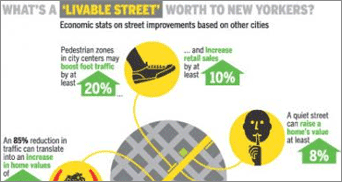Measuring the Value of Livable Streets
 Ever wonder how much New York stands to gain by making its streets more livable? Transportation Alternatives has been gathering evidence measuring the economic and social benefits that accrue when cities put pedestrians first. Their report is coming out next week, but the Observer published a sneak preview (headline: "The Woonerf Deficit") this Tuesday:
Ever wonder how much New York stands to gain by making its streets more livable? Transportation Alternatives has been gathering evidence measuring the economic and social benefits that accrue when cities put pedestrians first. Their report is coming out next week, but the Observer published a sneak preview (headline: "The Woonerf Deficit") this Tuesday:
The Dutch call it a woonerf — a “livable street” resplendent
with wide sidewalks, ample retail, greenery and minimal automobile
traffic. It’s designed to boost quality of life for citizenry, the till
for retailers and property values for landowners. Perhaps you’ve
noticed that New York City doesn’t have many woonerfs amid its warren
of streets, which make up one-fourth of the city’s land area.But what if it did?
Retail sales and property values would jump;
pollution and noise would drop; and contentment among those lucky
enough to live near or on a livable street would abound.
The full report promises to raise a lot of good questions. One leaps to mind already: Given the rewards to be reaped from more pedestrian-oriented streets and less traffic, will the city continue to enable car–dependent projects in the pursuit of its goals for housing and economic development?
Graphic courtesy of the Observer; click through for full version.